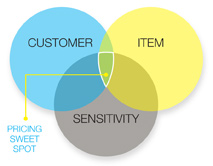The price is right
Turning customer value into shareholder value with smarter pricing
by Brent R. Grover
The chaotic pricing function continues to be an untapped source of profit improvement
opportunities for industrial distributors. The traditional delegation of pricing decisions to account executives is complicated because the sales reps are overwhelmed with detail work and do not have true market pricing information available.
Routine pricing for smaller customers is not the highest and best use of a sales rep's time. The reps are forced to make snap pricing decisions based on hunches and
in fear of losing orders and customers. The distributor sales rep, most often paid commissions based on gross margin dollars, has little incentive to risk his or her
ongoing income by gambling on getting a few dollars of extra selling price.
Distributors lose profit dollars during times of sharp upswings and downswings in commodity pricing. Sales reps cannot keep up with the constant changes in market pricing. They sometimes fail to pass along price increases, and often miss opportunities to build margin when costs decline. Industrial supplies sales reps are at an information disadvantage when negotiating with large customers. The customer knows what competitors are quoting but the sales rep does not. Reps who do not have true market pricing information cannot negotiate with confidence and do not obtain the most profitable outcomes for themselves and their companies.
The industrial distributor pricing challenge is summed up in the question, "How do I turn customer value into value for our company?" The extreme imbalance of supply and demand has shifted the pricing power to customers in spite of the tremendous value industrial distributors bring to their customers.
The "science" of pricing strategically is the application of straightforward pricing analytics.
Smarter pricing requires using your transaction database to segment your customers based on how they buy and by their buying power. You can determine how sensitive the customer is to a particular item, or group of products, by analyzing what and how each buys and comparing that information to the buying habits of similar customers for like items. The Venn diagram shows the relationship between the customer (segment, buying power and buying habits); the item (product class, manufacturer, brand, visibility); and the pricing sensitivity of the customer toward the item and similar products. The intersection, where the three circles overlap, is the pricing sweet spot:
 The "art" of strategic pricing is an exercise in change management. One-third of the staff in an industrial distribution business has customer-facing responsibilities. Success in strategic pricing can only happen with the support of the sales and sales support teams. Winning their hearts and minds requires a strong communications effort to build trust, overcome objections and demonstrate success.
The "art" of strategic pricing is an exercise in change management. One-third of the staff in an industrial distribution business has customer-facing responsibilities. Success in strategic pricing can only happen with the support of the sales and sales support teams. Winning their hearts and minds requires a strong communications effort to build trust, overcome objections and demonstrate success.
Our experience with building a strong pricing foundation for distributors shows that very little resistance comes from customers. Most of the challenges are from the distributor sales team. Winning change management requires patience, skill and experience.

Brent Grover can be reached at the Evergreen Consulting office in Cleveland (216) 360-4600 or brent@evergreen-consulting.com. Brent is the author of the best-selling NAW book Strategic Pricing for Distributors (www.nawpubs.org) and is a prolific author and frequent speaker at industry events.
This article originally appeared in the May/June 2011 issue of Industrial Supply magazine. Copyright 2011, Direct Business Media.











